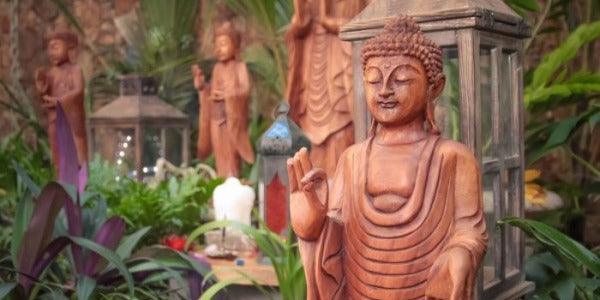At first glance, mudras are simply hand gestures ; but like everything that involves Hindu and Buddhist iconography and spiritual practice , as well as yogic science , they have an extremely rich symbology that relates the macrocosm (the universe) and the microcosm (the body).
In Sanskrit , an ancient Asian language, mudra is literally translated as a seal, but it can also be referred to as a mark or spiritual gesture that provides balance.
It is believed that, like the universe, the body is made up of five basic elements: fire ( agni ), air ( vayu ), ether or space ( aakaash ), earth ( prithvi ) and water ( jal ). And that in the fingers of the hands are important energy channels to access and manipulate them. Each finger features an elemental connection medium!

Jnana mudra is the coming together of fire (agni) and air (vayu) and represents knowledge.
The thumb connects us to fire, which symbolizes the universal self, the higher consciousness ; the index connects us to air, which portrays the individual self and governs creative capacity, divine inspiration ; the medium makes us access the ether, which figures the ego and grants energy to live and harmonize with spirituality.
Already the ring , connects us to the earth, represents the mind and provides strength to fight for what we believe; and the minimum brings us closer to water, which concerns human relationships and works on our emotions.
By combining them, connecting them and forming the gesture, a specific effect is produced on the body and mind. 399 combinations are listed, among which 36 are the most used concomitantly with asanas (physical postures), pranayamas (breathing exercises) and mantras during meditative practices , spiritual rituals, dances and yoga .

It is common to find the jnana mudra together with asanas featuring sculptures of buddhas.
The balance provided by inserting a mudra in the home decor is also noticeable in the energy of the environment . For this reason, we highlight the five most frequent in the decorative arts and the respective healing powers they evoke:
Characterized by the joining of the index finger (air) with the thumb (fire), the jnana mudra symbolizes spiritual progress and knowledge - when the human being (individual self) bows before divine wisdom (universal self). It can also be found as gyan , vitarka or chin mudra.
Its presence in the environment regulates the flow of the air element in the body, stimulates the pituitary glands, endocrine glands and pituitary gland. It gives clarity to reasoning, increases calm and concentration, improves memory and mood, assists meditative practice , reduces sleep disturbances and relieves depression and hypertension.

The union of the thumb and the middle forms the akasha mudra, a combination of ether and fire.
The akash mudra is also very present in the iconography of decorative deities , and can have variations such as: akasha , shunya , shuni , aakash and akaash vardhak mudra. It is formed by joining the middle finger (ether) with the thumb (fire) and has the power to expand the cosmos in our body, so that the other four elements have room to act.
This internal increase has a detoxifying action, as it is provided by the elimination of metabolic waste and the purification of negative emotions and thoughts. Decreases physical pain, such as ear pain, and emotional discomfort, restores confidence and patience, increases mental cognition, intuition, and self-expression.

In decoration, mudras help to balance the energy of the environment.
In Sanskrit, abhaya means fearlessness, the dispelling of fear. And that's exactly what this third mudra represents. Consisting of five outstretched fingers, this gesture - also referred to as hamsá - enhances the energy flow of all the elements in the body, regardless of the direction in which it is portrayed: with the palm facing the sky or the earth, or with the tips of the fingers facing up or down.
In censers and decorative sculptures it inspires emotional security, divine protection and inner peace; calms mental activity, removes attachment, blesses the environment and makes us recognize the oneness of the universe, the non-existence of duality "inside" and "outside", as we are all one.

The atmanjali mudra is better known as namaste; expresses respect and gratitude.
The atmanjali mudra or namaste is certainly the most known and practiced gesture in the world. It is formed by joining the hands with the fingers stretched out at the height of the heart chakra , nevertheless it is considered a mudra of love. It balances the two hemispheres of the brain, elevates the state of consciousness and meditation, expresses gratitude and offers a sense of calm, balance and embracement - in the body and in the environment.
The dhyana mudra - another gesture of Hindu and Buddhist iconography expressed in buddha decorative arts - is the most reproduced in meditations, as it leads us to deep concentration. It is made with the palms of the hands facing upwards, in which the right hand, which symbolizes enlightenment, is superimposed on the left, which represents Maya, the illusion of the world. In the gesture, the thumbs meet and denote the integration of the universe.
Usually performed in conjunction with padmasana (lotus flower asana), this mudra transmutes sexual energy, clears the mind and helps to see clearly. In the decoration of the environment , it reduces stress, grants tranquility and balance to seek spiritual elevation.

Mudras balance the five elements within us.
In short, mudras are expressed in decorative arts as mandalas , paintings and buddha statues . And it is through them that we reverberate in the environment the balance we seek in our interior.
Get inspired in our online store !
Namaste!
Milene Sousa - Art & Tune











1 comment
Amei o conteúdo